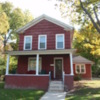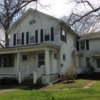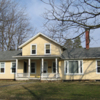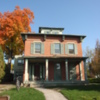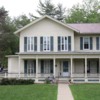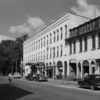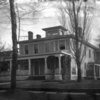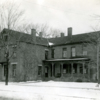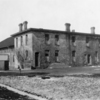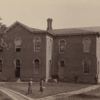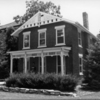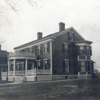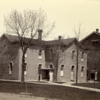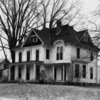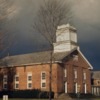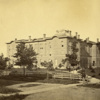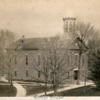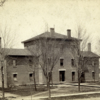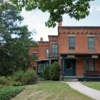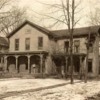Browse Items (21 total)
Village Housing: 201 N. Professor Street
This house has been known as the Mitchell-Sage-Young House, after several of its many owners and residents. It is a vernacular house with Greek Revival elements, and retains some of its historical features despite modern alterations. It is now one of…
Village Housing: 197 W. Lorain Street
The core of this house was built in 1854; many additions have been made to it since then. In 1862, Sela G. Wright, an ardent missionary to the Chippewa Indians in Red Lake, Minnesota and a contributor to the abolitionist movement, bought the house.…
Village Housing: 51 N. Cedar Street
The Greek Revival farmhouse--two wings flanking a main block with columned portico--was one of America's most popular domestic adaptations of the Greek temple form, and can still be seen gracing the landscape from New England through the South and…
Charles Martin Hall House
Originally a beautiful mansion, this house is presently used by the College as Village Housing for students. It is historically significant for its association with an important American industrialist, Charles Martin Hall, and the process he…
Lewis (Edmonia) Center for Women and Transgender People
The Edmonia Lewis Center for Women and Transgender People is named after Mary Edmonia Lewis, an Oberlin student from 1859-1862 and famed sculptor. It is a collective of students, staff, and administrators who strive to transform existing systems of…
Park Hotel/Oberlin Inn (1st)
In 1866 Henry Viets offered to erect a hotel on the site of the former village hotel (built in 1833-34 and destroyed by fire in 1866), provided the College and citizens of the town contributed $5,000 toward its erection. The Trustees of the College…
Tags: 1860s, brick and mortar, commercial, hotel, inn, mid-19th century, post-Civil War
Cranford
Cranford was purchased by the College for use as a women's dormitory and dining hall for men and women in 1946 from Mrs. Bertha Pope Cairns. At the time of purchase Cranford housed 43 women and provided board for 82 men and women. The farm estate,…
Stewart Hall
Stewart Hall was a two-story brick building, used for many years as a private residence. It was first rented by the College in 1880, and was purchased March 10, 1881 at a cost of $5,000, which included an additional lot. Stewart Hall was a dormitory…
Women's Gymnasium (2nd)
This brick structure, two stories in height, was built in 1881 located south of the Ladies Hall (Second). It was ready for use in September, 1881. The lower floor was used for gymnasium purposes, while the upper furnished dormitory accommodations for…
Men's Gymnasium (1st)
Ground was broken for the Men’s Gymnasium in November, 1860, and the building was opened with appropriate exercises on Saturday, March 30, 1861. It was built by the “Gymnasium Association.” It was located in Tappan Square, northwest…
Society Hall
The construction of Society Hall was begun in 1867 and completed in 1868. It was a two-story brick building built at the same time and in the same style as French Hall, located on the west side of the Campus near the north end. As originally…
Daub House
This plain brick house, built during the Civil War, was updated later in the 19th century with the decorative wooden porch and bargeboard. It was called the Bailey-Gager Place, named for the Massachusetts shoemaker, William Bailey, who built it in…
Geography Building/East Lodge
Beginning in 1929 the house on the property at 86 West Lorain Street was used for the department of Geology and Geography as headquarters for the work in Geography. The house was built in the early 1840s by Professor Henry Cowles and was located on…
French Hall
The construction of French Hall was begun in 1867 and completed in 1868, at the same time and in the same style as Society Hall. It was a two-story brick building, located on the west side of Tappan Square, near the south end, named in honor of…
Ellis Cottage
The former home of Professor John Millott Ellis was purchased by the College in 1906. In the summer of 1914 it was remodelled for college purposes and used as a house of residence for women. It accommodated fifteen women, who took their meals…
First Church in Oberlin
First Church in Oberlin, originally First Congregational Church, was built from plans by Richard Bond, a prominent New England architect whom Charles Grandison Finney met while recruiting faculty in Boston. Building the church was a massive community…
Ladies Hall (2nd)
The foundations for the Second Ladies Hall were laid in the spring of 1861, at the breaking out of the Civil War. Work upon the building proceeded slowly. The walls were put up and the building enclosed in 1863. At the Commencement exercises in 1865…
College Chapel (Old)
The College Chapel was begun in 1854 and was completed in 1855. It was located on the campus south of Tappan Hall. It was built of brick, two stories in height, with dimensions 56 by 90 feet. As originally planned, the first floor contained offices…
Cabinet Hall
Cabinet Hall was constructed by the village of Oberlin in 1851 for public school purposes. It was located north of the Mahan-Morgan House, and south of the location now occupied by Peters Hall. It was purchased by the College in 1874. It afforded six…
Allencroft
Built in 1861 by Ralph Plumb, a hero of the Oberlin-Wellington Rescue, Allencroft was occupied beginning in 1865 by Dr. Dudley Allen. In 1899 the property was given to the College by Allen’s son, Dudley Peter Allen and his sister Emily Allen…
Administration Building (Temporary)
After the College Chapel burned down in 1903, the administrative offices were moved to a frame residence at 122 West College Street. The building contained a two-story brick vault, that would supposedly protect the contents from fire. However,…

